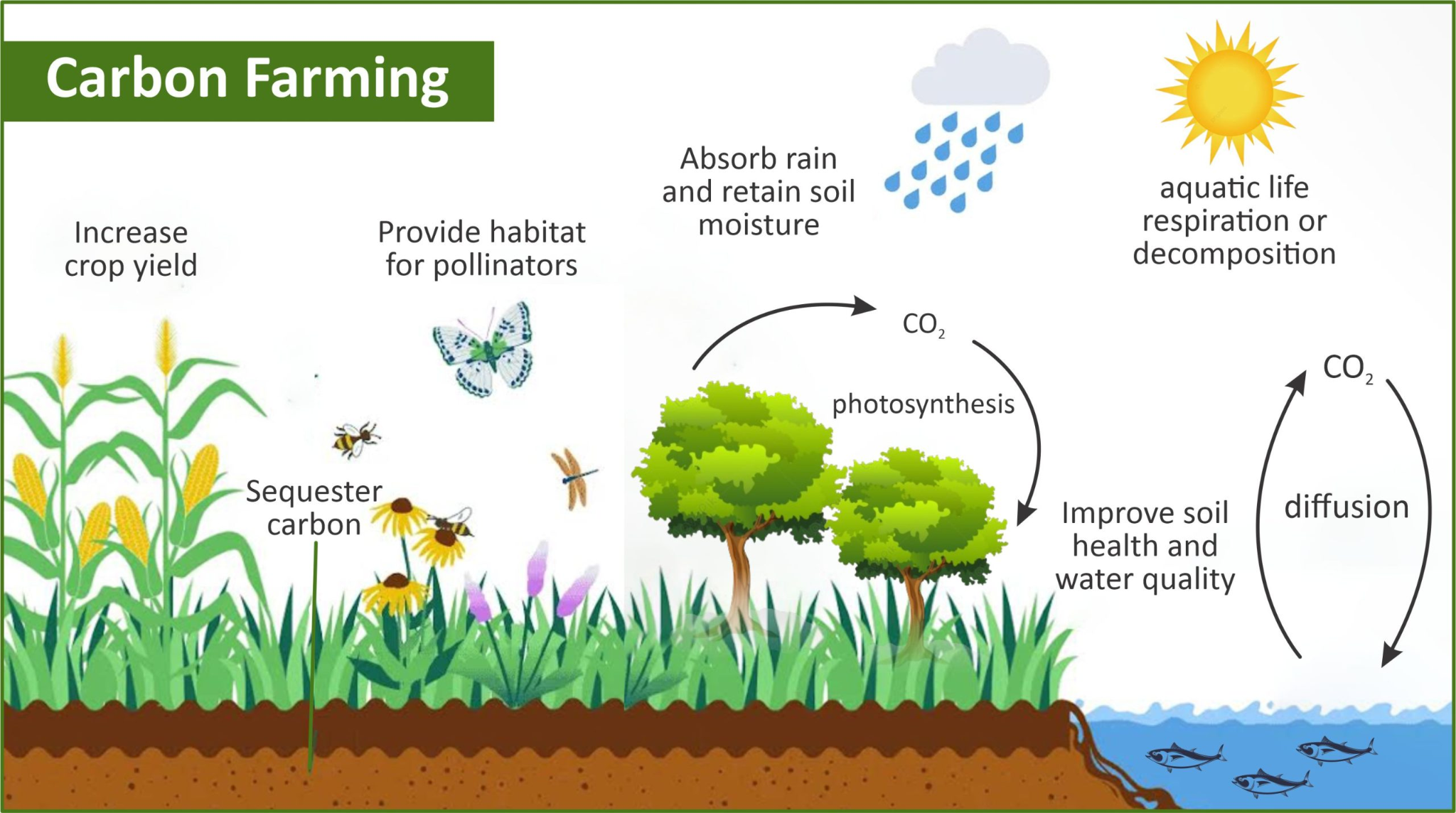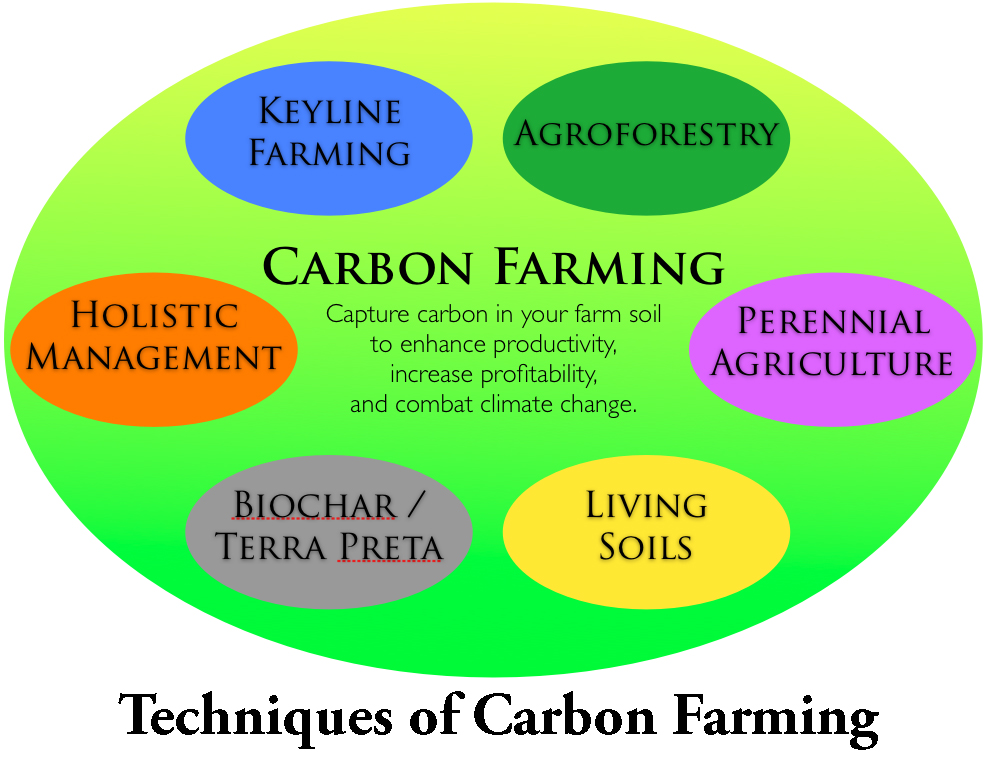Carbon Farming: A Pathway to Sustainable Agriculture | 11 May 2024
This editorial is based on “What is carbon farming?’’ which was published in The Hindu on 07/05/2024. The article brings into the picture some techniques within carbon farming that can reduce greenhouse gas emissions and the challenges in implementing such techniques, especially in developing countries such as India.
For Prelims: Carbon farming, Climate-resilient agriculture, photosynthesis, carbon sequestration, biomass, organic matter. climate change, Net Zero goals, carbon credit markets, greenhouse gas (GHG), Renewable energy facilities, greenhouse gas (GHG), zero tillage, Small-scale farmers, Temperature, Precipitation, Biomass accumulation.
For Mains: Significance of Carbon Farming for Indian Agricultural Practices.
In light of escalating environmental concerns and the pressing need for climate-resilient agricultural practices, carbon farming has emerged as a crucial mechanism within the agriculture sector globally.
Carbon, present in all living organisms and numerous minerals, serves as a cornerstone of life on earth, exerting significant influence over diverse processes such as photosynthesis and respiration; farming involves caring for the land, growing crops, and raising animals for food.
What is Carbon Farming?
- About:
- Carbon farming represents a strategic approach aimed at maximising carbon sequestration and employing agricultural practices designed to enhance the absorption of carbon dioxide (CO2) from the atmosphere while facilitating its retention in both plant biomass and soil organic matter.
- This process requires careful planning, monitoring, and adaptation to local conditions to maximise its effectiveness in mitigating climate change.
What is the Significance of Carbon Farming?
- Climate Change Mitigation: Carbon farming is pivotal in the fight against climate change by sequestering carbon in soil and curbing greenhouse gas emissions.
- Soil Health Enhancement: By nurturing healthy soil, carbon farming bolsters water retention, diminishes erosion, and boosts nutrient availability, resulting in amplified crop yields and agricultural productivity.
- Converting organic waste into compost, which can be used as a soil amendment to improve soil structure, fertility, and carbon content.
- Biodiversity Enrichment: Carbon farming fosters biodiversity by fostering intricate ecosystems in agricultural settings, attracting beneficial insects and pollinators that fortify crop health and lessen dependence on pesticides.
- Economic Opportunities: Implementation of carbon farming practices opens avenues for farmers to tap into carbon credit markets, alongside potentially augmented yields from enriched soil, thus diversifying income streams and bolstering financial resilience.
What are the Techniques Involved in Carbon Farming?
- Forest Management
- Healthy forests absorb and hold carbon dioxide emissions produced from other sources and are an important source of greenhouse gas (GHG) sequestration. Carbon offsets can be created through a variety of strategies including, avoiding deforestation and permanent land conservation, reforestation and replanting activities, and improved forest management.
- Agroforestry not only sequesters carbon but also provides additional sources of income for farmers and deforestation contributes to 15-20% of the rise in greenhouse gas levels globally, activities to address this include managing forests by thinning them out, selectively harvesting trees, encouraging regrowth, planting new trees, and using fertilisers to help forests grow in a productive and sustainable way.
- Grasslands Conservation
- Native grasses and other vegetation provide a natural source of greenhouse gas (GHG) absorption and sequestration.
- Carbon offsets from this category focus on maintaining native plant life through permanent land conservation and avoiding conversion for commercial development or intensive agriculture.
- Renewable Energy Production
- Renewable energy facilities such as wind or solar, generate carbon offsets by displacing fossil fuel-based electricity production sources within the power grid.
- The carbon offsets derived from a certified third-party project generates the carbon credit, which is owned by the entity that develops the project.
- Conservation Agriculture Techniques
- Methods like zero tillage, crop rotation, cover cropping, and crop residue management minimise soil disruption while fostering organic matter accumulation.
- Planting cover crops during fallow periods to protect and enrich the soil, enhance biodiversity, and sequester carbon.
- Rotational Grazing
- It entails periodically relocating livestock to new pastures, this practice allows previously grazed areas to rejuvenate, minimising erosion and fostering robust regrowth.
- The flourishing vegetation, in return, absorbs carbon dioxide from the atmosphere and sequesters it in the soil through photosynthesis.
What is the Role of Mangrove in Carbon Sequestration?
- Carbon Storage:
- Mangroves store large amounts of carbon in their above-ground biomass, below-ground roots, and organic-rich sediments.
- The dense vegetation and slow decomposition rates of organic matter in mangrove soils result in substantial carbon accumulation over time.
- Blue Carbon Ecosystem:
- Mangroves are part of the "blue carbon" ecosystem, which refers to the carbon stored in coastal and marine habitats like mangroves, seagrasses, and salt marshes.
- Despite covering less than 0.1% of the Earth's surface, mangroves sequester and store a disproportionately high amount of carbon compared to other ecosystems.
What are the Potential Opportunities for Carbon Farming in India?
- Economic Opportunity: India's extensive agricultural base presents significant economic opportunities through the adoption of carbon farming practices with an estimated potential of $63 billion from approximately 170 million hectares of arable land.
- Carbon Credit Systems: Implementation of carbon credit systems can offer additional income streams to Indian farmers by recognising their contributions to environmental services.
- Agricultural soils in India have the potential to sequester 3-8 billion tonnes of CO2 equivalent annually over 20-30 years, thus providing opportunities for farmers to participate in carbon trading markets.
- Regional Suitability: Different regions of India offer varying degrees of suitability for carbon farming initiatives.
- The fertile plains of the Indo-Gangetic region and the expansive Deccan Plateau are particularly favourable for implementing carbon farming practices.
- However, regions such as the Himalayan foothills and coastal areas face specific challenges, including mountainous terrain and salinisation, which may require tailored approaches to carbon farming implementation.
What are Global Carbon Farming Initiatives:
- Carbon Trading: In certain nations such as the US, Australia, New Zealand, and Canada, voluntary carbon markets are emerging.
- These platforms enable farmers to earn extra income by engaging in verified carbon sequestration endeavours, thereby encouraging the uptake of carbon farming techniques.
- Other Global Efforts: Initiatives like the '4 per 1000' initiative.
- Kenya’s Agricultural Carbon Project (backed by the World Bank) was introduced at the 2015 United Nations Climate Change Conference (COP21) in Paris.
- Australia's Carbon Farming Initiative, advocate for carbon farming on a global scale.
- India’s Legal Framework: The Government of India passed an amendment in 2022 to the Energy Conservation Act 2001, which lays the foundation for the Indian Carbon Market. Following this, the Council On Energy, Environment And Water (CEEW) conducted an industry stakeholder discussion to understand their concerns and perspectives.
- This issue briefly deconstructs the two key typologies of carbon markets – project-based/offset and Emission Trading Scheme (ETS) markets and outlines their key features that determine their environmental integrity and functional boundaries.
What are the Challenges Associated to Carbon Farming?
- Soil Composition: Soils with poor structure or low organic matter may have limited capacity for carbon storage and may require amendments or management practices to enhance fertility and carbon sequestration potential.
- Geographic Location: Geographic factors like elevation, slope, and proximity to water bodies also impact land use options and agricultural productivity.
- For example, high-altitude regions may have limited crop options due to colder temperatures, while coastal areas may face challenges related to saltwater intrusion and soil salinity.
- Varieties of Crops: The selection of crop varieties suitable for specific soil types, climates, and growing seasons is critical for optimising agricultural productivity and carbon sequestration potential, varieties that are well-adapted to local conditions and resilient to pests, diseases, and extreme weather events can enhance crop yields and contribute to soil health and carbon storage.
- However, limited availability of diverse crop varieties or lack of access to improved seeds may constrain farmers' ability to maximise carbon farming benefits.
- Water Scarcity: Adequate water is essential for plant growth and photosynthesis, which are fundamental processes for carbon sequestration.
- Arid regions face challenges in carbon farming due to inadequate water availability, which impedes plant growth and reduces the capacity for carbon sequestration.
- Financial Constraints: Small-scale farmers in developing nations like India often encounter financial barriers, struggling to afford the initial costs associated with implementing sustainable practices essential for carbon farming.
- Limited Policy Support: The absence of robust policy frameworks and insufficient community engagement hinder the widespread adoption of carbon farming practices, impeding its potential impact on mitigating climate change.
What Strategies can be adopted to Encourage Carbon Farming?
- Legal Framework for Carbon Farming: Enacting comprehensive carbon farming legislation can showcase the concept of creating carbon sinks on agricultural lands and this approach can address climate crises, improve agricultural sustainability, and promote equitable development.
- Direct Incentives for Farmers: Recognising the pivotal role of the agriculture and forestry sectors in carbon capture, it is imperative to provide direct incentives in form of tools and credit support for adopting climate-friendly practices, existing policies lack targeted tools to significantly incentivise the expansion and preservation of carbon sinks.
- Utilising Carbon Credits and Banks: Rewarding farmers with globally tradable carbon credits and establishing carbon banks can incentivise carbon sequestration efforts. These mechanisms can facilitate the sale of credits to corporations seeking emission offsets, thus promoting sustainable land management.
- Collective Engagement: A successful framework for carbon farming necessitates cohesive policies, public-private collaborations, precise quantification methods, and supportive financing mechanisms. Implementation at a scalable level is crucial for achieving measurable carbon capture while ensuring soil health and resilience.
- Unlocking Soil Potential: Soil, an overlooked climate defence, serves as a potent carbon sink. India must harness its potential to meet Net Zero goals and pursue decarbonisation.
|
Drishti Mains Question: What strategies can be employed to ensure the effective implementation of carbon trading in the agriculture sector, thereby mitigating greenhouse gas emissions and fostering sustainable farming practices? |
UPSC Civil Services Examination, Previous Year Question:(PYQ)
Prelims:
Q.1 Which of the following statements best describes "carbon fertilisation"? (2018)
(a) Increased plant growth due to increased concentration of carbon dioxide in the atmosphere.
(b) Increased temperature of Earth due to increased concentration of carbon dioxide in the atmosphere.
(c) Increased acidity of oceans as a result of increased concentration of carbon dioxide in the atmosphere.
(d) Adaptation of all living beings on Earth to the climate change brought about by the increased concentration of carbon dioxide in the atmosphere.
Ans: (a)
Q.2 Which one of the following statements best the term ‘Social Cost of Carbon’? (2020)
It is a measure, in monetary value, of the -
(a) long-term damage done by a tonne of CO2 emissions in a given year.
(b) requirement of fossil fuels for a country to provide goods and services to its citizens, based on the burning of those fuels.
(c) efforts put in by a climate refugee to adapt to live in a new place.
(d) contribution of an individual person to the carbon footprint on the planet Earth.
Ans: (a)


